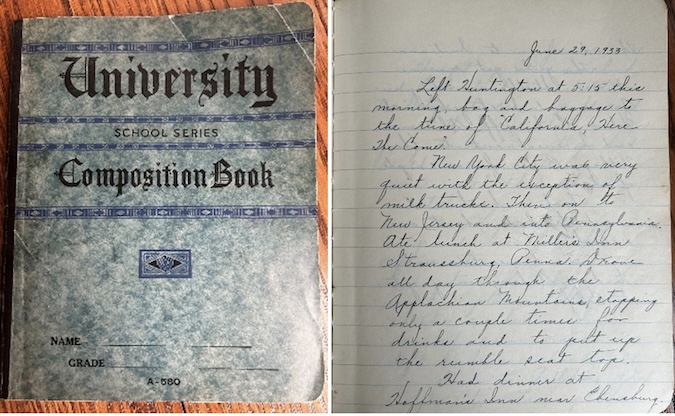Journal from 1933 details Waterport woman’s trip with 4 friends to California
Cross-country journey by car included many stays in roadside cabins
By Catherine Cooper, Orleans County Historian
“Illuminating Orleans” – Volume 4, No. 17
“Miss Helen Millis, who was accompanied by four girlfriends on a motor trip from Long Island to San Francisco and back, has returned to her home in Waterport.” – Lyndonville Enterprise, August 17,1933.
What an adventure it must have been! Helen kept a journal account of the trip, which her niece, Luann Millis Tierney, recently shared with the Orleans County Department of History. It is a charming read and offers a view of a different era of travel.
The big trip began at 5:15 a.m. on the morning of June 28, 1933, when Eve, Alice, Ann, Carle and Helen left Huntington, Long Island to the tune of “California, Here We Come.” Helen observed that New York City was very quiet, “with the exception of the milk trucks.”
On to Pennsylvania and through the Appalachian Mountains, they logged 416 miles on their first day and stayed overnight with friends in Indiana, Pa. Next day, they headed south and joined Route 40 at Pittsburgh. Also known as the Lincoln Highway, this route – which was entirely paved by 1931 – traversed the country and connected New York City to San Francisco.
They drove each day, stopped for food at roadside stands or diners, and stayed overnight at cabins with names such as Cottonwood Cabins or Al Smith’s Cabins. Automobile ownership had ballooned by the 1930s, roads had been improved and Americans were on the move. Clusters of these rustic, box-like cabins sprang up along busy routes to provide accommodation for travelers. The girls did not “book ahead” and rarely had a problem securing a place to stay at the end of the day.
From Pittsburgh, they travelled on through Columbus to Indianapolis where they visited the Indiana War Memorial and were impressed by its art and architecture. She described Indiana and Illinois as “very monotonous. The air is saturated with pigs.”
The prairie was “most interesting.” But July 8th was “the most thrilling day of the trip so far.” Helen wrote nine enthused pages about their visit to the Cave of the Winds, and the rail trip on the Cog Railroad (tickets $3.50 each) to Pike’s Peak, the sights, the exhilaration, what the guides told them. “A grand trip I shall never forget.”
They headed south to New Mexico and visited Taos, the Painted Desert, and the Petrified Forest. Their first view of the Grand Canyon was from Yavapai Point. She wrote:
“Had I looked at its beauty many more minutes, I should have been overcome by its magnetic power.”
They traversed west on Route 66 and negotiated the intimidating Oatman Hill. Of the hairpin bends she wrote:
“You almost met your spare tire going around some of them.”
They arrived in Southern California on July 14, the 17th day of the trip. On to Long Beach where they rented an apartment for a few days to explore the area. Having rested, they set off to Yosemite National Park, the Mariposa Giant Sequoias, and through the terrifying Tioga Pass. Carson City, Reno, Salt Lake City, Pocatello, Yellowstone National Park, Casper, Cheyenne where they enjoyed some rodeos, and then to Omaha, Nebraska. They motored on to Chicago and spent two days visiting the World’s Fair exhibits. Through Sandusky, Ohio finally to Buffalo on August 6th.
“Cleopatra” as they named the car, served them well. Helen did not specify the make or model but referred to bringing it to a Chrysler dealer for repairs. They frequently had the car “greased.” They had one flat tire, ran out of gas once, and had some carburetor problems towards the end of the trip. The “freewheeling” problem that Cleopatra experienced as they were descending the Oatman Pass was the most dangerous. Luckily, a truck driver attached chains to the back of the car and prevented them from descending too quickly.
Cleopatra sported a “rumble seat,” which was basically the trunk lid reversed to provide extra seats. It was open to the elements and probably had little or no suspension. Helen was invariably a rumble seat passenger when it rained. On a few rainy occasions, they simply pulled off the road and into a farmer’s barn to wait for the rain to pass.
In the era before cell phones and pay phones, the girls communicated their travel progress to their families at home by postcard. On several occasions, Helen refers to “picking up mail” – their families wrote letters to them and mailed them to certain prearranged cities. Not as instant as texting, but it worked.
These girls were independent and confident. Then in their early 20s, they enjoyed dances and rodeos along the way. Helen mentions just one occasion when they felt uncomfortable, but they just brazened it out.
Helen lived to be 104 years old. Born in 1909, she was the daughter of Carl A. and Cora Miller Millis of Waterport. The family resided at the Breezy Ridge Fruit Farm on what is now Fuller Road. One of eight siblings, Helen graduated from Waterport High School, Geneseo Normal and Training School, and Syracuse University. She married Beryl Livingston. An elementary school teacher, she taught on Long Island and later the Fayetteville-Manlius Elementary School, Syracuse. She retired in 1977 and passed away in 2014.
She ended her travel journal:
“Lockport, Gasport, Middleport, Medina, Albion, and I was almost home. Uncle Richard, Dad, Sally, Jack, and Roger met me about 6:30. It surely seemed good to be home again. And it was a grand trip!”
































































